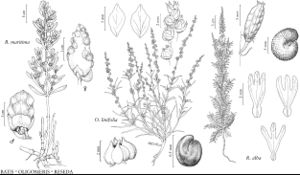Herbs [shrubs], annual, biennial, or perennial; usually glabrous, sometimes puberulent (producing glucosinolates). Stems erect or ascending; unbranched or branched. Leaves cauline and sometimes basal; rosulate or not; alternate, sometimes fasciculate, simple; venation pinnate; stipules present (modified into glands, interpetiolar, distinct); petiole present; blade (sometimes pinnately lobed, base somewhat decurrent on petioles) margins entire, pinnatisect, or with 1–2 hyaline teeth. Inflorescences usually terminal, sometimes axillary, racemes or spikes; bracts present. Pedicels present or absent. Flowers bisexual [unisexual or polygamous], ± zygomorphic (almost actinomorphic); perianth and androecium hypogynous [rarely perigynous]; sepals persistent or deciduous, 2–6 [–8], distinct or basally connate, equal or unequal, margins usually hyaline; petals [0–] 2–6 (–8), imbricate, distinct or connate, rotate, attached to receptacle, heteromorphic, lateral and abaxial (anterior) usually progressively smaller, adaxial (superior) ones larger, clawed, margins entire or incised; intrastaminal nectary-discs present or absent, asymmetrical, simple [double]; stamens 3–40 (adaxial ones shorter); filaments persistent or deciduous, distinct or basally connate, glabrous or scaberulous; anthers dehiscing by longitudinal slits, introrse, tetrasporangiate (pollen shed as single grain), binucleate, commonly 3-aperturate, colpate or colporate; pistils [2–] 3–4 [–6 (–8)], connate [distinct or basally connate] (± open apically), each with an apical tooth (style and stigma) containing stigmatic tissue; ovary [2 or] 3 or 4 [6 (–8)]; placentation parietal [basal-axial or marginal], placenta usually entire, sometimes apically forked; ovules 1–many per locule, campylotropous, bitegmic. Fruits capsules [sometimes free carpidia], valvate [fleshy], cylindric, ovoid-oblong, subglobose, or ovoid, ± open apically; gynophore present (sometimes minute, hidden by surrounding disc). Seeds 3–ca. 30, brownish or dark-brown to black, reniform, papillose, rugose, or smooth; not arillate; endosperm scanty or none; cotyledons incumbent.
Distribution
North America, n Mexico, Europe, sw, c Asia, n, s Africa, Atlantic Islands, temperate and subtropical regions, in c Mexico, South America, Australia
Discussion
Genera 6, species ca. 85 (2 genera, 5 species in the flora).
Placement of Resedaceae in the Capparales or Brassicales is well settled, based on morphological, anatomical, and molecular criteria, and the shared presence of glucosinolates (mustard oil glucosides). The family has been traditionally considered closest to Brassicaceae and Capparaceae. Molecular data (J. C. Hall et al. 2002, 2004) revealed an unexpected relationship to the Australian endemic Gyrostemonaceae and two genera of Capparaceae (Forchhammeria and Tirania). The foundations of the taxonomy of Resedaceae were established in the nineteenth century primarily through the work of J. Müller Argoviensis (1857, 1868), who recognized three tribes within the family (Astrocarpeae, Cayluseae, Resedeae) based on ovary and placentation type. Validity of his tribal classification was confirmed by later morphological and molecular studies (M. S. Abdallah and H. C. D. de Wit 1978; S. Martín-Bravo et al. 2007). Apparently, the only species of the family native to the New World is Oligomeris linifolia (see below).
Selected References
Lower Taxa
Illustrations
| Family ⠉ | Taxon | Illustrator ⠉ | |
|---|---|---|---|
 | Bataceae Resedaceae Resedaceae | Batis maritima Oligomeris linifolia Reseda alba | Yevonn Wilson-Ramsey Barbara Alongi Barbara Alongi |
Key
| 1 | Leaf blades 0.8-5 × 0.05-0.2 cm, margins usually entire, sometimes toothed near base with 1-2 hyaline teeth; inflorescences usually dense spikes (or spikelike racemes); pedicels absent or nearly so; petals 2-3; stamens 3-4; intrastaminal nectary-discs absent. | Oligomeris |
| 1 | Leaf blades 3-15 × 0.5-5 cm, margins entire, pinnatisect, or lobed; inflorescences racemes; pedicels present; petals 4-6; stamens 10-40; intrastaminal nectary-discs present. | Reseda |